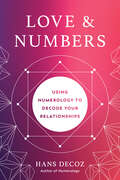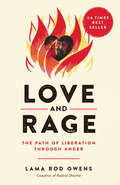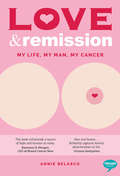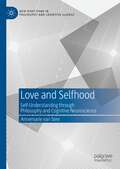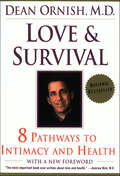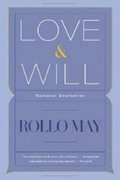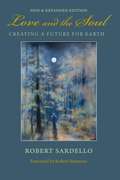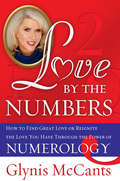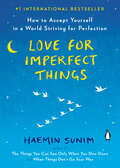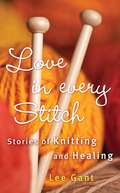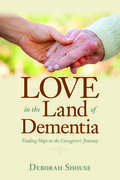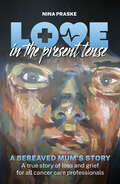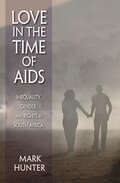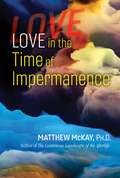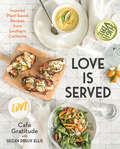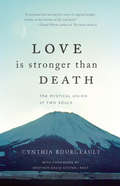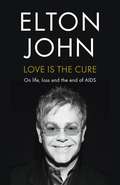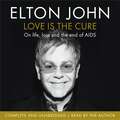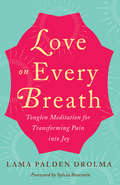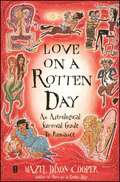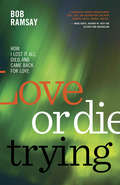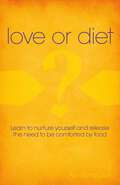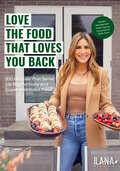- Table View
- List View
Love and Numbers: Using Numerology to Decode Your Relationships
by Hans DecozDive deep into your relationships, discover the secrets of compatibility, and embrace the power of numbers--from a Numerology expertNumbers have a way of following you throughout your life. Birth dates, anniversaries, ages, lucky numbers--they're always there. Numerology reveals the significance of these numbers and helps you to uncover hidden truths about your personality and how you relate to the people in your life. In Love and Numbers, world-renowned numerologist Hans Decoz reveals the secrets of numerology and how it describes and illuminates your relationships. You will learn how to calculate your Life Path number (no math required!), and that of your partner, and discover the ways in which your numbers are compatible--or not. With in-depth analysis of every possible pairing, this book will reveal how you and your partner are suited for one other. Whether you are soul mates or a case of opposites attracting, Love and Numbers will help you learn more about one another and strengthen your bond.
Love and Rage: The Path of Liberation through Anger
by Lama Rod OwensIn the face of systemic racism and state-sanctioned violence, how can we metabolize our anger into a force for liberation?White supremacy in the United States has long necessitated that Black rage be suppressed, repressed, or denied, often as a means of survival, a literal matter of life and death. In Love and Rage, Lama Rod Owens, coauthor of Radical Dharma, shows how this unmetabolized anger--and the grief, hurt, and transhistorical trauma beneath it--needs to be explored, respected, and fully embodied to heal from heartbreak and walk the path of liberation. This is not a book about bypassing anger to focus on happiness, or a road map for using spirituality to transform the nature of rage into something else. Instead, it is one that offers a potent vision of anger that acknowledges and honors its power as a vehicle for radical social change and enduring spiritual transformation.Love and Rage weaves the inimitable wisdom and lived experience of Lama Rod Owens with Buddhist philosophy, practical meditation exercises, mindfulness, tantra, pranayama, ancestor practices, energy work, and classical yoga. The result is a book that serves as both a balm and a blueprint for those seeking justice who can feel overwhelmed with anger--and yet who refuse to relent. It is a necessary text for these times.
Love and Remission: My Life, My Man, My Cancer (Inspirational Series)
by Annie BelascoIn her mid-twenties, balancing a stable job and a partying lifestyle, Annie was also on the hunt for a man. She wanted to find Mr Right, get married, buy a house, and live the life she’d always wanted. But then one day, she found a lump ...Breast cancer. The two words that would derail Annie’s life. Suddenly she realised how short her life had been, and the very idea of finding love seemed impossible. As her hair fell out, and her social life crumbled, her mental health deteriorated. She began to question if she would actually survive. Struggling with an identity crisis and worryingly low moods, she wondered if she’d ever be able to live the normal life that had been within her reach only months earlier.Love and Remission tells the tale of a young woman in search of love and mental wellbeing.
Love and Selfhood: Self-understanding Through Philosophy and Cognitive Neuroscience (New Directions in Philosophy and Cognitive Science)
by Annemarie van SteeAfter years of neurohype and a neuroskeptic backlash, this book provides a systematic analysis of the contributions to self-understanding cognitive neuroscience (CNS) and philosophy can make. The stories of five people in search of self-understanding serve as touchstone throughout the book. Their identities are tied up with what they love. The book provides in-depth analyses of CNS of love and CNS of self-reflection. It critically discusses philosophers who focus on the relation between love, self-understanding and selfhood, such as Harry Frankfurt, Susan Wolf, Charles Taylor and Søren Kierkegaard. It also builds an argument about CNS’ contributions to self-understanding more broadly, and how different these are from philosophy’s contributions. The book develops conceptual review as a philosophical method for improving the validity and comparability of CNS studies. It integrates CNS insights into its philosophical view on love and selfhood where applicable. This book thus argues and exemplifies that philosophy and CNS can work together.
Love and Survival: Healing Power of Intimacy, The
by Dean OrnishThe Medical Basis for the Healing Power of IntimacyWe all know that intimacy improves the quality of our lives. Yet most people don't realize how much it can increase the quality of our lives -- our survival.In this New York Timesworld-renowned physician Dean Ornish, M.D., writes, "I am not aware of any other factor in medicine that has a greater impact on our survival than the healing power of love and intimacy. Not diet, not smoking, not exercise, not stress, not genetics, not drugs, not surgery."He reveals that the real epidemic in modern culture is not only physical heart disease but also what he calls spiritual heart disease: loneliness, isolation, alienation, and depression. He shows how the very defenses that we think protect us from emotional pain are often the same ones that actually heighten our pain and threaten our survival. Dr. Ornish outlines eight pathways to intimacy and healing that have made a profound difference in his life and in the life of millions of others in turning sadness into happiness, suffering into joy.
Love and Will
by Rollo MayAccording to Rollo May, the heart of man's dilemma is the failure to understand the real meaning of love and will, their source and interrelation. Bringing fresh insight to these concepts, May shows, in this book, how we can attain a deeper consciousness.
Love and the Soul: Creating a Future for Earth
by Robert SardelloWith economies in peril, war in the Middle East, genocides, global warming, and a host of other grim phenomena, the world has never seemed so besieged. The solution, says Robert Sardello, lies with the individual. In this timely, thoughtful book, he explains how the soul can engage with the outer world to produce radical change. Because we think of the world as a vast mechanism and behave as mechanical objects in it, the results are devastation and dysfunction. The key is to learn to identify with the plight of the Earth by developing a true sense of individual imagination and conscious awareness of inner purpose and beauty in conjunction with the soul of the world. Sardello shows how to achieve this awareness and bring what is inside out into the world, inspiring balance and stability. Using the Grail legend and the myth of Sophia--known as the Soul of the World--as well as writings by Jung, James Hillman, and Rudolf Steiner,Love and the Soulhelps readers imagine a revitalized Earth by exploring the significance of grieving, the transformative power of radical receptivity, the creative power of dreaming, and a new basis for community.
Love at First Bite: The Complete Vampire Lover's Cookbook
by Michelle Roy KellyEverything's better with vampires--even dinner! Now you can serve up delicacies your guests will love, and satisfy your ravenous cravings at the same time. Love at First Bite is a unique collection of more than 300 suckulent recipes sure to tempt the taste buds and leave everyone begging for more, including:Blood Chilling GazpachoVan Helsing's Veggie RollsBloody Mary FondueCoffin CakeI Vant S'moresBlood Orange MimosasThis ghastly guide also includes clever themes for vampire parties, with menus and movies for some bloody good fun. With Love at First Bite, making meals for monster appetites just got easier!
Love by the Numbers
by Glynis MccantsInternational bestselling author and media sensation Glynis McCants created this exciting guide to love through the power of Numerology because she believes that the greatest gift one can receive is that of true and lasting love. The secret is in understanding you and your partner by the Numbers, and gaining the insights you need to keep your love thriving! Glynis' celebrated system is a contemporary spin on the ancient Science of Numerology that is easy to use and amazingly accurate. She'll teach you the simple way to create a Numerology Blueprint that reveals what kind of mate would fulfill your—or a potential mate's—innermost needs and desires.
Love for Imperfect Things: How to Accept Yourself in a World Striving for Perfection
by Haemin Sunim Lisk FengSusan Cain, New York Times bestselling author of Quiet: "The world could surely use a little more love, a little more compassion, and a little more wisdom. In Love for Imperfect Things, Haemin Sunim shows us how to cultivate all three, and to find beauty in the most imperfect of things--including your very own self."A #1 internationally bestselling book of spiritual wisdom about learning to love ourselves, with all our imperfections, by the Buddhist author of The Things You Can See Only When You Slow DownHearing the words "be good to yourself first, then to others" was like being struck by lightning.Many of us respond to the pressures of life by turning inward and ignoring problems, sometimes resulting in anxiety or depression. Others react by working harder at the office, at school, or at home, hoping that this will make ourselves and the people we love happier. But what if being yourself is enough? Just as we are advised on airplanes to take our own oxygen first before helping others, we must first be at peace with ourselves before we can be at peace with the world around us.In this beautiful follow-up to his international bestseller The Things You Can See Only When You Slow Down, Zen Buddhist monk Haemin Sunim turns his trademark wisdom to the art of self-care, arguing that only by accepting yourself--and the flaws that make you who you are--can you have compassionate and fulfilling relationships with your partner, your family, and your friends. With more than thirty-five full-color illustrations, Love for Imperfect Things will appeal to both your eyes and your heart, and help you learn to love yourself, your life, and everyone in it.When you care for yourself first, the world begins to find you worthy of care.
Love in Every Stitch: Stories of Knitting and Healing
by Lee GantIn her inspiring book, Love in Every Stitch: Stories of Knitting and Healing, master knitter, teacher, and widely published knitwear designer Lee Gant shares real-life stories about the power of knitting. As an employee of three different yarn stores, a teacher of countless knitting classes, and a volunteer with at-risk youth, Lee has had the opportunity to gather diverse stories. The stories Lee shares about herself and fellow knitters from around the world illustrate how each stitch and purl can comfort and calm, heal and renew. A suicidal teenager crochets through pregnancy. A dying woman finds comfort in the company of knitters. A woman finds the courage to face her estranged parents. A woman going blind realizes she can still knit -- and experience life. And Lee's life, riddled with more than just anxiety, has at last become stable and productive. This book includes stories of women, men, and teens who have experienced profound change and enlightenment through knitting and crochet.
Love in the Land of Dementia
by Deborah ShouseThe hard lessons learned while taking care of her parents as her mother died slowly from Alzheimer's and her father died unexpectedly during the process are presented compassionately and lyrically. The book contains a great spiritual message as well as practical support for caregivers and other family members.
Love in the Present Tense: A Bereaved Mum's Story
by Nina PraskeA celebration of a life, a story of a death, but most importantly an exploration of grief and loss relevant to all those in a position to make that experience more bearable.This book is essential reading for anyone working or preparing to work with young adults and others facing terminal illness, and their families. It is written by a bereaved mother of a 25 year-old son treated unsuccessfully for cancer. Heartbreakingly honest, Nina draws on relevant theory, research and narrative texts as well as personal reflections. She considers what might have made the hideous journey through treatment, dying and bereavement easier to bear. This is a moving and memorable story for all of us, but there are also learning points throughout for medics and medical policy makers specifically and the health and social care professions more generally. Students and experienced nurses, doctors, counsellors, clerics and others will benefit from deepening their understanding in order to work more effectively with people facing the unthinkable.
Love in the Time of AIDS: Inequality, Gender, and Rights in South Africa
by Mark HunterIn some parts of South Africa, more than one in three people are HIV positive. Love in the Time of AIDS explores transformations in notions of gender and intimacy to try to understand the roots of this virulent epidemic. By living in an informal settlement and collecting love letters, cell phone text messages, oral histories, and archival materials, Mark Hunter details the everyday social inequalities that have resulted in untimely deaths. Hunter shows how first apartheid and then chronic unemployment have become entangled with ideas about femininity, masculinity, love, and sex and have created an economy of exchange that perpetuates the transmission of HIV/AIDS. This sobering ethnography challenges conventional understandings of HIV/AIDS in South Africa.
Love in the Time of Impermanence
by Matthew McKay• Shows how the certainty of change and loss can support rather than diminish love • Shares practices and meditations to help love endure in the face of loss, disappointment, change, or any of the ways relationships and circumstances are altered by time • Explores how to cultivate gratitude for every expression of love we encounter, strengthen compassion for others, and recognize the power of love after life Collaborating with his late son, Jordan, psychologist Matthew McKay offers five ways to keep love alive in a world of impermanence. He explores how to see and know what we love, how to actively care for what we love, how to have compassion for the suffering of others, how to set the daily intention to act with love, and how to turn toward rather than away from the pain of impermanence. McKay shares practices and meditations to help love endure in the face of loss, disappointment, change, or any of the ways relationships and circumstances are altered by time. He examines what love is and is not, including how not to mistake yearning and neediness for love, sex for love, and attraction to beauty for love. He shows how to cultivate gratitude for every expression of love we encounter, learn to care for things we don&’t like, and recognize the power of love after life--a love that reaches beyond death. He also provides concrete exercises for communicating with and channeling messages from loved ones who have crossed over. Ultimately, McKay shows that, by running from pain, we run from love. By avoiding pain, we lose the pathway to connection. Yet, by recognizing love in the heart of pain and loss, by knowing that change and impermanence are inevitable, we can navigate life with a compass pointing to love as true north, learning to love more deeply and making what we love more cherished.
Love is Served: Inspired Plant-Based Recipes from Southern California
by Seizan Dreux Ellis Café GratitudeBright, clean, and hip recipes to enchant vegans, vegetarians, and omnivores alike, from plant-based haven Café Gratitude.Before it was a fixture on the L.A. dining scene and a magnet for celebrity diners, Café Gratitude was founded in the Bay Area with the simple ethos that joy derives from loving and being grateful for food, health, and good company. The dishes are named to double as affirmations of self. "I Am Fearless," "I Am Humble," and "I Am Open-Hearted" nod to the restaurant's core belief that food is just as much about spirit as it is about appetite. Since then, the café has evolved quite a bit. It's changed locations, expanded, and been the backdrop for more paparazzi shots than one can count. But the founding principles have remained the same, and the food continues to celebrate the flavors of plants with organic, from-scratch, and healthful ingredients free of animal products, processed soy, and, in almost all cases, refined sweeteners.Now, with Love is Served, Seizan Dreux Ellis, executive chef at Café Gratitude, brings Gratitude-quality meals to your table and the soul and mission of the restaurant to your home. Indulge in café favorites "I Am Awakening" (Raw Key Lime Pie) and "I Am Passionate" (Black Lava Cake) while cooking up hearty, nourishing dishes like Grilled Polenta with Mushroom Ragout ("I Am Warm-Hearted") and Radicchio, Roasted Butternut Squash, and Sundried Tomato Pesto Grain Salad ("I Am Gracious"). With unfussy methods and easy-to-access ingredients, this cookbook makes the wholesome satisfaction of the restaurant as accessible as ever for the home cook as it charms and inspires readers to change the way they look at food.
Love is Stronger than Death
by David Steindl-Rast Cynthia Bourgeault"Ablaze with passion for the one essential task of the monk: total inner transformation". --Brother David Stendl-Rast"Libraries offering titles on mysticism, inner transformation, or dealing with grief will find this a unique and welcome addition."--Library JournalThis powerful book, written by an Episcopal priest, tells of her intense relationship with Brother Raphael Robin, a seventy-year-old Trappist monk and hermit. Both believed that a relationship can continue beyond this life, and here Cynthia Bourgeault describes her search for that connection before and after Robin's death. Bourgeault's previous books include The Wisdom Jesus and Centering Prayer and Inner Awakening.
Love is the Cure: On Life, Loss and the End of AIDS
by Elton JohnThe first ever book by music legend and author of the bestselling Me, Sir Elton John: a personal, passionate and illuminating journey of his fight to end the AIDS epidemic.In the 1980s, Elton John saw friend after friend, loved one after loved one, perish needlessly from AIDS. In the midst of the plague, he befriended Ryan White, a young Indiana boy ostracized by his town and his school because of the HIV infection he had contracted from a blood transfusion. Ryan's inspiring life and devastating death led Elton to two realizations: His own life was a mess. And he had to do something to help stop the AIDS crisis. Since then, Elton has dedicated himself to overcoming the plague and the stigma of AIDS. He has done this through the Elton John AIDS Foundation, which has raised and donated $275 million to date to fighting the disease worldwide. Love Is The Cure is Elton's personal account of his life during the AIDS epidemic, including stories of his close friendships with Ryan White, Freddie Mercury, Princess Diana, Elizabeth Taylor, and others, and the story of the Elton John AIDS Foundation. With powerful conviction and emotional force, Elton conveys the personal toll AIDS has taken on his life - and his infinite determination to stop its spread. Elton writes, 'This is a disease that must be cured not by a miraculous vaccine, but by changing hearts and minds, and through a collective effort to break down social barriers and to build bridges of compassion. Why are we not doing more? This is a question I have thought deeply about, and wish to answer - and help to change - by writing this book.' The sale of Love Is the Cure will benefit the Elton John AIDS Foundation.
Love is the Cure: On Life, Loss and the End of AIDS
by Elton JohnIn the 1980s, Elton John saw friend after friend, loved one after loved one, perish needlessly from AIDS. In the midst of the plague, he befriended Ryan White, a young Indiana boy ostracized by his town and his school because of the HIV infection he had contracted from a blood transfusion. Ryan's inspiring life and devastating death led Elton to two realizations: His own life was a mess. And he had to do something to help stop the AIDS crisis.Since then, Elton has dedicated himself to overcoming the plague and the stigma of AIDS. He has done this through the Elton John AIDS Foundation, which has raised and donated $275 million to date to fighting the disease worldwide. Love Is The Cure is Elton's personal account of his life during the AIDS epidemic, including stories of his close friendships with Ryan White, Freddie Mercury, Princess Diana, Elizabeth Taylor, and others, and the story of the Elton John AIDS Foundation. With powerful conviction and emotional force, Elton conveys the personal toll AIDS has taken on his life - and his infinite determination to stop its spread.Elton writes, 'This is a disease that must be cured not by a miraculous vaccine, but by changing hearts and minds, and through a collective effort to break down social barriers and to build bridges of compassion. Why are we not doing more? This is a question I have thought deeply about, and wish to answer - and help to change - by writing this book.'The sale of Love Is the Cure will benefit the Elton John AIDS Foundation.(P)2012 Hachette Audio
Love on Every Breath: Tonglen Meditation for Transforming Pain into Joy
by Lama Palden DrolmaToday, when our human family is facing so many challenges, it is more important than ever that we find peace and sustenance in our hearts. Love on Every Breath, or Tonglen, is an eight-step meditation for anyone who wants to nourish and open their heart. An ancient and profound meditation that has been practiced in isolated mountain retreats in the Himalayas for centuries, it is now available to us in the modern world. Lama Palden Drolma, a Western teacher trained by Tibetan Buddhist masters and also schooled in contemporary psychotherapy, introduces readers to the meditation in this powerful, user-friendly book. She walks readers step-by-step through the meditation, from beginning issues of sitting with awareness and focusing on the breath to taking in and extending love. Real-life challenges of sadness, anger, and overwhelm are addressed with &“On-the-Spot&” versions of the meditation. Love on Every Breath is a meditation that changes our experience in the moment — and changes our lives.
Love on a Rotten Day: An Astrological Survival Guide to Romance
by Hazel Dixon-CooperThe irreverent guide to losing -- or finding -- your true soul mate In love with an obtuse Taurus, a drunk Pisces, or a hotheaded Aries? Forget traditional astrology and visit the maladjusted side of the universe. Love on a Rotten Day debunks myths, reveals flaws, and examines the dubious virtues of every sign, while still showing how to tame the Leo or outwit the Gemini that you're hooked on. In this refreshingly honest guide to love, author Hazel Dixon-Cooper shows you how to: Safely dump a Scorpio Snag a romance-phobic Aquarius Get rid of that clingy Libra Convince a Virgo to have spontaneous sex Make a Sagittarius monogamous Keep a wandering Gemini happy at home It also includes "Fatal Attractions" -- an irreverent sun sign compatibility guide -- and a scorecard for each sign, from Best Bets (in and out of bed) to Just Good Friends. Traditional astrology texts won't tell you how to disentangle your Cancer boyfriend from around your ankles so that you can have a night out with your friends -- but they will tell you that he is a "nurturing homebody." Likewise, they fail to warn you that the sweet nothings your Pisces girlfriend whispers are more her fantasies than actual truth, and that the passionate nature of your Aries lover is confined to on-demand sex and nightly temper tantrums. Luckily, Love on a Rotten Day offers brazenly honest profiles of all the sun signs (including the disagreeable parts) and takes a deeper look into everyone's emotionally mixed-up Moon, Mars, and Venus signs. Author and Cosmopolitan Bedside Astrologer Hazel Dixon-Cooper delivers the goods on the cheaters, manipulators, bullies, brats, nutcases, and nymphos of the zodiac. (Whether this is good or bad, well -- that's up to you.) She also offers helpful tips on how to best use your own inner brat to win those endless games that lovers play. An honest and uproarious guide to losing and finding your true soul mate (and everyone before, after, and in between), Love on a Rotten Day is the perfect book to have handy before you ask anyone "What's your sign?"
Love on a Rotten Day: An Astrological Survival Guide to Romance
by Hazel Dixon-CooperThe Guide to Losing -- or Finding -- Your True Soul MateDid you know: Capricorns are cowards when it comes to public displays of affection? Aries get amorous in unusual places? Leos love to be serviced? Cosmo's Bedside Astrologer, Hazel Dixon-Cooper, reveals all this and more in this sexy, uninhibited guide to love and romance, the follow-up to her hip and hilarious Born on a Rotten Day. In Love on a Rotten Day, Dixon-Cooper walks the wild side of the zodiac, delivering the goods on which sign cheats and who's a manipulator, a bully, a brat, a nutcase, or a nympho. Lovers, would-be lovers, and ex-lovers will rejoice in advice on how to: Safely dump a Scorpio Convince a Virgo to have spontaneous sex Snag a romance-phobic Aquarius An honest and uproarious guide to losing and finding your true soul mate, Love on a Rotten Day is this century's answer to the timeless query "What's your sign?"
Love or Die Trying: How I Lost It All, Died, and Came Back for Love
by Bob Ramsay"A ruthlessly honest memoir of love, loss, and redemption." — WADE DAVISA story of addiction and recovery, love and perseverance, and a reminder that it’s never too late to start over.Bob Ramsay had it all — and lost it all, often. At forty, he lived in a drug treatment centre in Atlanta. Starting over back in Toronto, he began dating an older woman, a doctor named Jean Marmoreo, who had three teenage kids. The chances of this relationship lasting were zero. But they married and created a very different “out there” life for themselves, climbing mountains, running marathons, and exploring the ends of the earth.Then one day Bob’s heart stopped, and life got much worse after it was restarted. But once again, perseverance and love won over fate, and today, Bob turns connection into an art form, while Jean Marmoreo is a MAiD doctor, leading her patients across the thin veil between life and death.Love or Die Trying is a love story that unfolded against all odds and a reflection on a life anchored between a first death and the future.
Love or Diet: Nurture Yourself and Release the Need to be Comforted by Food
by Ani RichardsonAre you doing battle with your body? Do you desperately want to end your obsession with food, emotional eating and yo-yo dieting and come to a place of deep peace? Are you ready to begin living in a new and empowered way, not using food to keep you small? Struggles with food and emotional eating are often a signal that something deeper is going on, a kind of soul-call. Love or Diet will help you to follow that soul-call safely and explore your eating patterns in a way that can lead to complete freedom and peacefulness with food. In Love or Diet, nutritionist and editor of www.nurturewithlove.com, Ani Richardson, aims to change your relationship with food, but more importantly, change your relationship with your deepest Self, because when you are willing to courageously look at what you are attempting to stuff down with food, you can begin to heal and shine light on the perceived darkness in our lives, one delicious ray at a time.
Love the Food that Loves You Back: 100 Recipes That Serve Up Big Portions and Super Nutritious Food
by Ilana MuhlsteinHealthy Recipes for Every Step of Your Weight Loss Journey"Get ready to indulge in creative and delicious recipes that serve up big portions and huge inspiration! This cookbook will no doubt become one of your secret weapons in the kitchen!" —Lisa Lillien a.k.a. Hungry Girl#1 Best Seller in Low Fat Cooking, Low Cholesterol Cooking, and High Protein DietsIlana Muhlstein’s own 100-pound weight loss journey gives her the cutting edge in guiding thousands on their weight loss journey. Ilana’s first book You Can Drop It, was published by Simon & Schuster in 2020 and has sold over 50,000 copies.Recipes for everyone in your tribe. Ilana has healthy recipes for the whole family to enjoy. From easy snacks for kids, lunch ideas for adults, to delicious dinner ideas, this cookbook for nutrition is packed with healthy recipes. “Foods that love you back" are low calorie, super healthy and high volume foods, meaning you can eat a LOT of them. You don’t have to lose your figure to feed your family!Don’t sacrifice good food while trying to lose weight. Have you been on a high cholesterol diet? Are you looking for recipes to lower cholesterol? Have you been looking for a cookbook for nutrition? Are you looking for the next healthy bestselling cookbook? Well, you're in luck! Ilana created this cookbook full of healthy recipes that allow you to eat delicious and well-seasoned meals while also losing weight and keeping your health in check. You can eat more and weigh less, we show you how!Inside, you’ll find:Healthy recipes to make easy snacks and lunch ideas for adults and kids alikeRecipes to lower cholesterol, lose weight, and keep up a healthy eating lifestyleThe eating plan and recipes in this book helped Ilana Muhlstein, who has lost over 100 pounds without sacrificing great mealsIf you liked Whole Food For Your Family, The Well Plated Cookbook, or Simple and Delicious Vegan, you’ll want to read Love the Food That Loves You Back.
